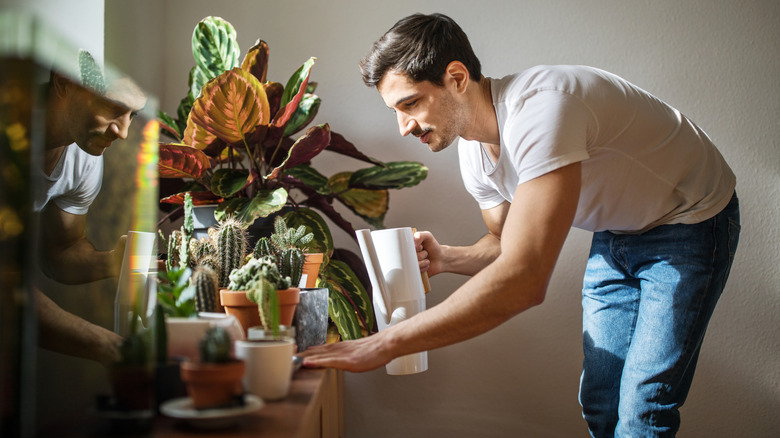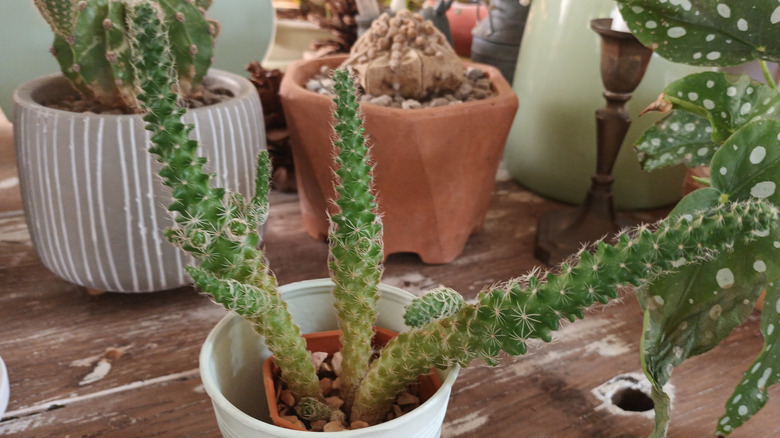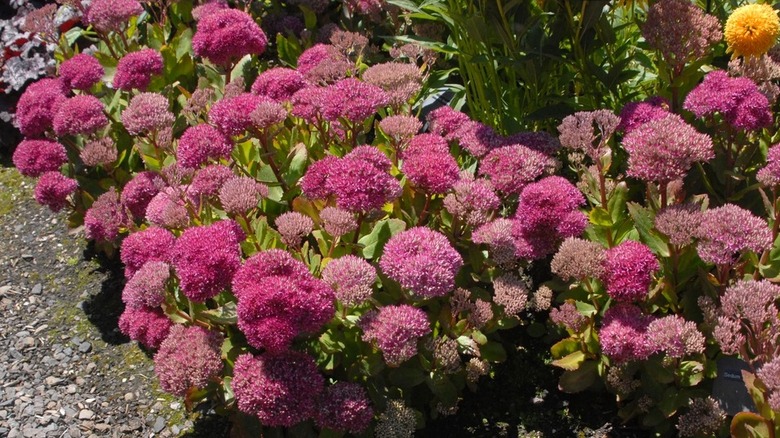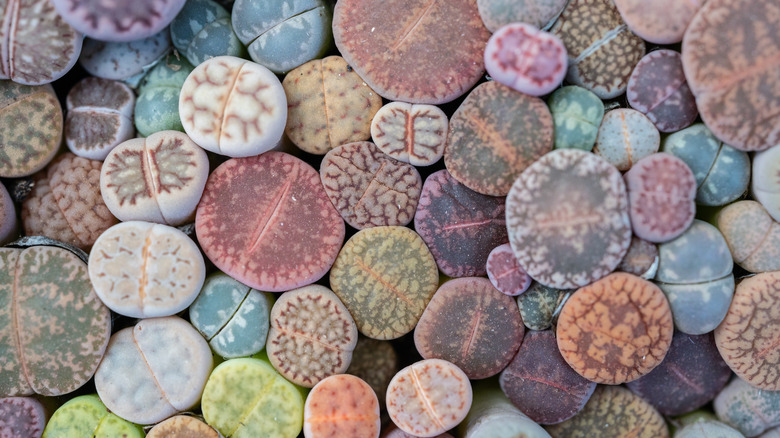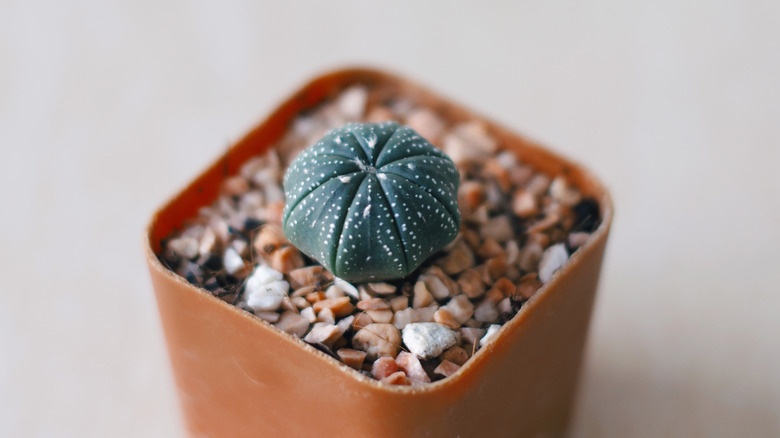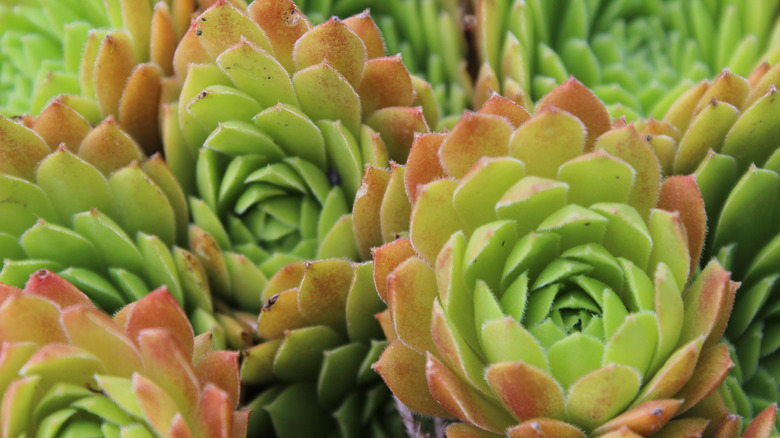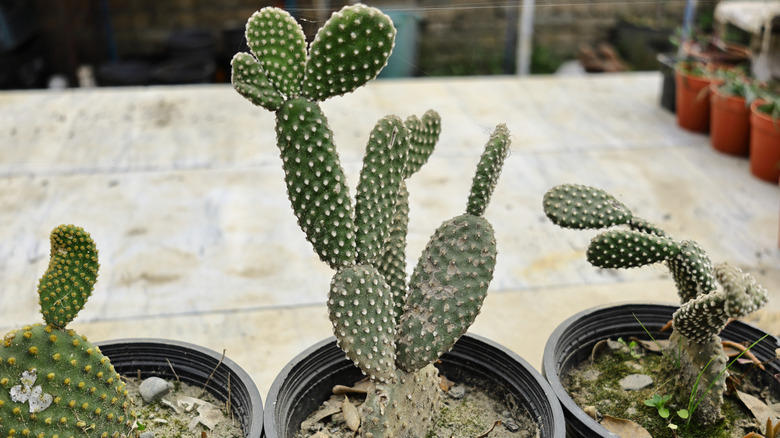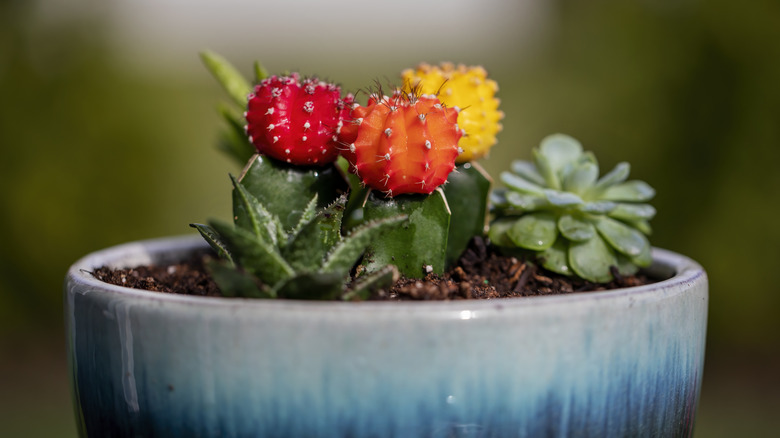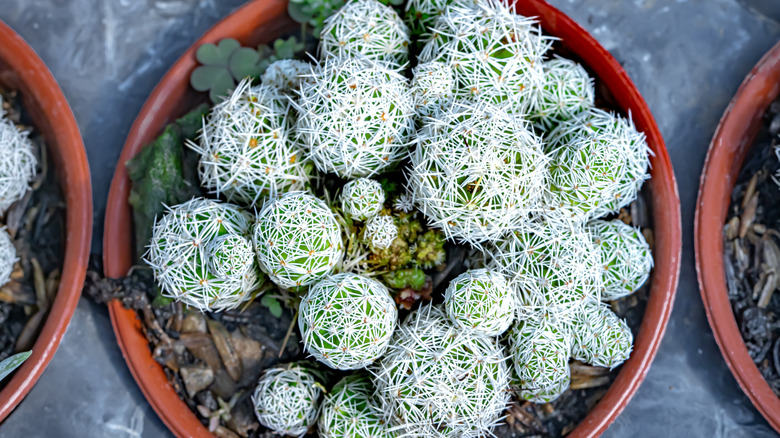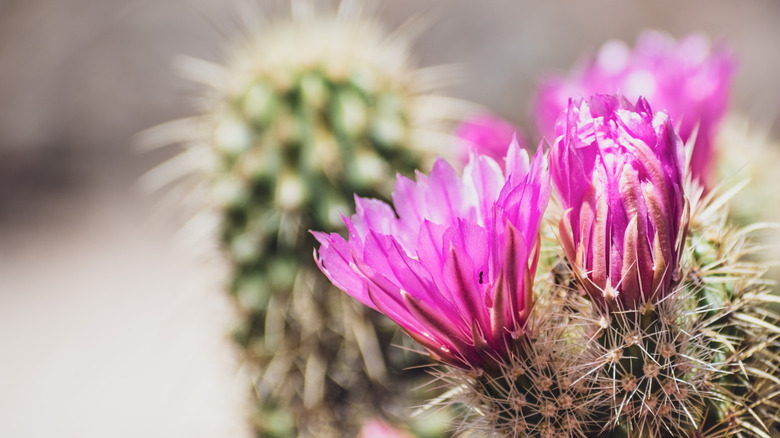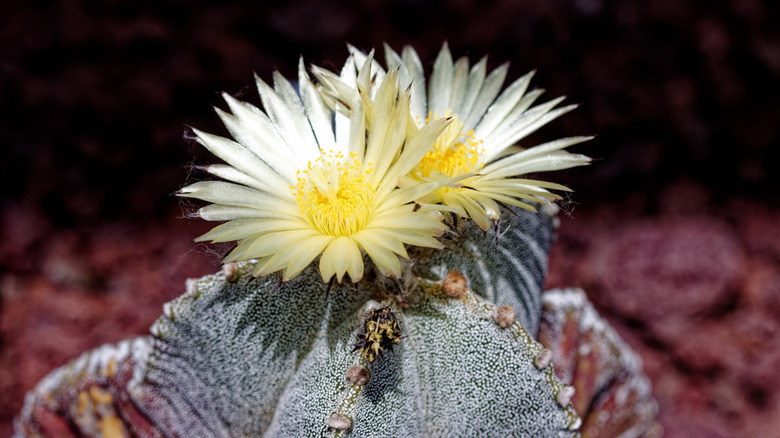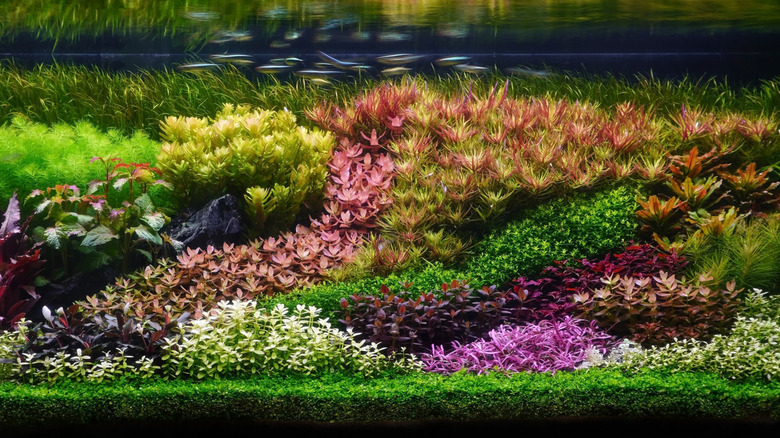Nontropical Plants That Will Thrive In Your Low-Humidity Home
We may receive a commission on purchases made from links.
Indoor gardening is a great hobby that not only brightens your space, but may even improve your mental and physical health, and remove harmful VOCs from the air. Unfortunately, those benefits go away once your plants start looking like they've spent a week in the Sahara. Ideally, indoor humidity should hover between 40% and 60% for most houseplants. Tropical plants, in particular, crave humidity levels as high as 80%, and placing them in a room with just 40% humidity can lead to stress, leaf drop, and even death.
Many homes, especially those with central heating or air conditioning, suffer from chronically low humidity, often dipping below 30%, creating a desert-like environment for tropical houseplants. But before you give into the idea that only plastic plants are the ones that can survive in your space, there's a whole world of nontropical houseplants that thrive in dry conditions and can remain perfectly content when your hygrometer reading drops to 30% and below. So, ditch the humidifier and get ready to welcome some hardy, low-humidity, nontropical plant champs into your home that prove you don't need to turn your living room into a rainforest to have a thriving indoor garden.
Eve's needle cactus (Austrocylindropuntia subulata) loves hot, dry indoor conditions
Eve's needle cactus (Austrocylindropuntia subulata) is a sculptural, almost alien-looking plant that's perfectly suited for dry indoor environments. Native to the arid regions of the Peruvian Andes, this cactus has evolved to thrive in low-humidity conditions. Its thick, fleshy stems and minimal leaf surface area help it conserve water, making it well-adapted to homes where humidity levels are consistently low. Think of it as the ultimate low-maintenance roommate that's content to sit in a sunny spot with minimal fuss. Overwatering is its nemesis, so if you're prone to forgetting to water your plants, this one might just be your perfect match.
Eve's needle cactus thrives in humidity levels between 30-50%. To keep it happy, provide it with plenty of bright, direct sunlight, like by a south-facing window. Use a well-draining cactus mix to prevent root rot and water sparingly, allowing the soil to dry out completely between waterings. During the winter months, when the plant is dormant, water even less frequently. And remember, while it's a hardy plant, it's not immune to neglect, so keep an eye out for signs of pests or disease, and give it a little love now and then. If you're looking for cacti to grow underneath your windows for added security, Eve's needle is ideal for this, and will easily root from stem segments, which you can harvest when your indoor specimen gets established.
Birthday party sedum is considered very adaptable to multiple humidity levels
Birthday party sedum (Sedum 'Birthday Party') is a succulent with ginormous, 5-inch blooms that bring a festive touch to any indoor space — and is perfectly happy in your dry home. Originating from arid regions in East Asia, this plant has adapted to store water in its thick, fleshy leaves, which allows it to thrive in low-humidity environments. Plus, its compact growth habit and vibrant colors make it a delightful addition to any windowsill or shelf.
To keep birthday party sedum thriving, ensure it receives ample bright, indirect sunlight, as this encourages vibrant coloration. When watering, think "less is more." Allow the soil to become completely dry between waterings, and reduce even further during its winter dormancy. Use a gritty, well-draining succulent mix and make sure its pot has holes that let excess water drain through, which is crucial for preventing root rot. While generally resilient, keep an eye out for common succulent pests like mealybugs or scale, or signs of overwatering, as rot can become a problem faster than you think with succulents like these.
Lithops prefer low humidity and being left alone
Lithops, often called "living stones," are super cute houseplants that will stay small, while living up to 50 years (!), and are ideally suited for dry indoor environments. Originating from the arid regions of southern Africa, these plants are used to life without water, living in climates that have an average annual rainfall of only 20 inches, and some species are even adapted to areas that receive less than 4 inches a year. Their unique look is a type of camouflage that mimics the appearance of pebbles, helping to both protect them from herbivores, while also allowing them to thrive in dry, low-humidity conditions. The trick for their low-humidity thriving is a combination of only having two fused leaves and minimal surface area. Not only is it a neat look, but these factors let them store enough water for the plant to survive months without a drink, a necessity in their native habitat — and a perfect attribute for dry homes. In the area where they were first discovered by a botanist in 1811 humidity levels range between 20% and 40%.
Keeping these little stone-like plants happy requires a few things. Like other succulents, they'll do best in a south-facing window and need a gritty soil mix — think lots of sand and perlite. While lithops are just fine with low humidity, they're a little more finicky about their temperature requirements and will not survive in rooms with night temperatures lower than 40 degrees Fahrenheit. When it comes to watering, be super stingy and only water when the leaves start to wrinkle in summer, and not at all in winter (their two dormant periods). Give a few deep waterings in spring and autumn, allowing the soil to dry out in between. Lithops like things slow and steady, so pick a pot with drainage holes that you'll like for a while, because it could be up to 20 years before they need a bigger pot. If you make it happy, you may even get the occasional flower from the middle "crack" between its leaves. While they're slow growers, these plants are full of quirky charm, and their easy-going nature make them a fun addition to any dry indoor space.
The sand dollar cactus (Astrophytum asterias) does well in cool, dry rooms
The sand dollar cactus (Astrophytum asterias)is a quirky, otherworldly succulent that's right at home in your dry indoor space. Native to the arid regions of Mexico and parts of Texas, these cacti have evolved to thrive in environments with minimal rainfall and low humidity. Their unique star-shaped bodies stay low to the ground, so they require little to thrive and are covered in white speckles or spines, which help them reflect sunlight and conserve water. These adaptations make them perfect for homes where the air is consistently dry, as they're masters at making the most of limited moisture. To give you an idea of their ability in this area, the region in Mexico where a German botanist first discovered these cute, tough plants — called Tierra Caliente — regularly experiences humidity levels as low as 10%.
To keep a sand dollar cactus happy, you'll need to replicate its natural habitat in your space as much as possible. It thrives with bright, direct sunlight from a south-facing window. Use a well-draining sandy soil or a cactus/succulent mix in a pot with drainage holes. Water sparingly from March to October, allowing the soil to dry completely between waterings, and keep it completely dry during winter dormancy, at which point it needs temperatures between 41-59 degrees Fahrenheit. Once it's out of dormancy, give your cactus a hit of balanced, diluted fertilizer to improve the chances of it blooming. While they're generally slow growers, their unique appearance and minimal care requirements make them a great addition to any low-humidity indoor garden or new plant parent. Just remember, they're not fans of being moved around too much, so find them a cozy spot, repot only when necessary, and let them shine.
Hens and chicks (Sempervivum tectorum) are well-adapted to handle low humidity homes
Hens and chicks (Sempervivum tectorum) is a classic, low-maintenance succulent that's perfectly at home in your dry indoor space. Native to the mountainous regions of Europe, these plants have evolved to withstand harsh conditions, including drought, poor soil, and low humidity. Their rosette-shaped leaves form tight clusters that are designed to conserve water, making them ideal for homes where the air is consistently dry.
To care for your hens and chicks plant and keep it thriving, provide it with plenty of bright, direct sunlight, ideally from a south-facing window. A very well-draining, gritty succulent mix in a shallow pot with drainage holes is essential to prevent rot, which they're susceptible to, especially when kept indoors. Water sparingly, allowing the soil to dry out completely between waterings, and cut back to only when absolutely necessary during their winter dormancy. While hens and chicks are fairly resilient and hardy, aphids and mealybugs can be a problem, so watch out for signs they've infested your plant.
Bunny ear cactus (Opuntia microdasys) does best in cool, dry rooms in your home
The bunny ear cactus (Opuntia microdasys) is a unique type of cacti perfect for indoor spaces with low humidity. Native to Mexico, this cactus has evolved to thrive in arid conditions, with minimal rainfall and low humidity. Its flat, pad-like stems, covered in clusters of tiny, golden glochids (which look like soft hairs, but are actually tiny spines), help it conserve water, making it an ideal choice for homes where the air is consistently dry.
Opuntia genus plants, including the bunny ear cactus, can withstand extremely low relative humidity levels, ranging from 5% to 24%. To keep your bunny ear cactus happy, provide it with plenty of bright, direct sunlight, ideally from a south-facing window. A well-draining cactus mix in a pot with drainage holes is essential to prevent root rot and only water when necessary, allowing the soil to dry out completely. Be cautious when handling, as those seemingly soft glochids can sometimes lead to contact dermatitis for those with sensitive skin. During winter, it does best with cooler temps ranging between 50-65 degrees Fahrenheit, so don't position this plant right on the radiator.
The moon cactus (Gymnocalycium mihanovichii) is like getting two low-humidity loving plants in one
The moon cactus (Gymnocalycium mihanovichii) is a striking succulent that's well suited for dry indoor environments. The plant is actually two species grafted together that form a symbiotic relationship requiring surprisingly little care. The top, known as a scion, is a brightly colored mutant seedling of Gymnocalycium mihanovichii and cannot photosynthesize on its own due to a lack of chlorophyll, making it entirely reliant on the bottom cactus. Consequently, the bottom cactus, known as a rootstock, is typically Hylocereus undatus (commonly known as dragon fruit), a hardy, adaptable cactus type. Despite being a sort of Frankenstein's monster plant, the moon cactus has minimal water needs and is able to use that resilient rootstock to easily thrive in slightly dry indoor conditions.
To keep your moon cactus flourishing, provide it with plenty of bright, indirect sunlight, as direct sunlight can scorch the colorful scion. A well-draining cactus mix is essential to prevent root rot in the rootstock and water sparingly, allowing the soil to dry out completely between watering. Moon cacti are not frost tolerant and hate the cold, so move yours away from drafty windows during the winter when it's dormant. Unfortunately, despite its hardy nature, the moon cactus has a limited lifespan of only a few years, so don't feel bad if yours ends up in the compost pile faster than other plants on this list.
The thimble cactus (Mammillaria vetula) stays small, so it doesn't need lots of humidity to thrive
The thimble cactus (Mammillaria vetula) is a super charming, petite succulent that's easy to grow and perfectly suited for dry indoor environments. Native to the dryer regions of Mexico, this cactus is known for its small, globular stems covered in white, hair-like spines. These spines help reflect heat and protect these fleshy little plants (which are essentially like tiny water tanks) from being eaten for their moisture content by animals. All of these adaptations enable it to thrive in arid conditions with minimal rainfall and low humidity. To give you some idea of how low this tough succulent can go, the city of Dolores Hidalgo, which is situated in the heart of its endemic region, routinely experiences daily humidity lows of around 10%. This ability to tolerate low humidity levels, combined with its compact size and low-maintenance nature make the thimble cactus an ideal choice for homes with consistently dry air.
One neat trick that helps the thimble cactus maintain moisture in arid, low-humidity environments is raised tubercles — the part where the spines emerge from. Most other cacti use their ribs as storage, but the thimble cactus will open its tubercles to take in water and store it for extended periods of drought. Its flowers will also appear from the tubercles, making them very cool, versatile plant parts. Since this cactus is such a water-storing machine, you've got to be especially careful giving it a drink. Don't let the plant sit in water and always use well-draining gritty soil and a pot with drainage holes. Wait at least one week between waterings and ensure the soil is completely dry; cacti are remarkably resourceful, so even a little water in their soil will be enough for them to get a drink. Place your thimble cactus in a south-facing window that gets full sun, but handle with care. While its spines appear soft, they're sharp little buggers that can irritate the skin.
The pinkflower hedgehog cactus (Echinocereus fasciculatus) would love to live in your low-humidity home
The pinkflower hedgehog cactus (Echinocereus fasciculatus) is not only delightfully named, but is also a wonderful succulent that's perfectly suited for dry indoor environments. Native to the Sonoran desert of the southwestern United States and northern Mexico (where some areas experience humidity levels below 10%), its ribbed, cylindrical stems are covered in sharp spines that act as a defense against herbivores, but also help minimize water loss, allowing it to survive in areas where the air is extremely dry. Plus, the plant's natural habitat is harsh with intense sunlight and low moisture, making a home with dry air and a sunny window almost perfect for this tiny cactus to thrive.
To keep your pinkflower hedgehog cactus happy, give it plenty of bright, direct sunlight, ideally from a south-facing window and for at least six hours. A well-draining cactus mix and a pot with proper drainage is essential to prevent root rot. If you want your cactus to flower in the spring or summer, then it will need a period of winter dormancy where the temperature in the room gets between 40 to 50 degrees Fahrenheit. Be careful when handling, as those half-inch spines may be small, but are quite sharp. Fertilize during the growing season, usually from around June through September, with a low-nitrogen fertilizer for the best results.
Bishop's cap (Astrophytum myriostigma) needs low humidity to flourish
The bishop's hat cactus (Astrophytum myriostigma) is another unique-looking cactus that's perfect if your home is plagued by dry air. It's a type of star cactus and is uber chunky, starting out with a softball-sized body that's full of water-accumulating chloroplasts designed to keep the plant thriving in even the longest of droughts. The cactus will become more columnar as it matures, but still stays compact, helping to minimize surface area while a thick cuticle covers the entire body, preventing water loss.
Bishop's hats are awesome at handling humidity levels as low as 5%, so don't worry about whether your grow room is too dry. That said, be very careful not to overcompensate for the dry climate as overwatering can cause root rot, fungal diseases, or plant death. If you've already got a handle on how to care for a star cactus, follow the same principles for your bishop's hat. Water this cactus during its growing season with a good, deep soaking very sporadically and even less during its winter dormancy; this mimics its natural habitat and allows it to soak up the water it needs to grow or flower. Make sure the soil is very well-draining though and never water until its completely dry. Speaking of, flowering will take around six years, but is well worth the wait; it'll produce a single, super-fragrant flower that's like a trophy being handed to you as a thanks for a job well done.
Want something other than a cactus or succulent? Try growing aquatic plants in low-humidity homes
Now, this might feel like a bit like cheating, but aquatic plants are absolute champions when it comes to thriving in low-humidity homes. After all, they live in water! And you don't need a sprawling pond to enjoy them. Even small desktop aquariums can become vibrant, living ecosystems, adding a unique touch to your space and naturally boosting localized humidity, especially during the winter, which is great if you want to try adding a few houseplants that need at least average humidity. Think of it as bringing a mini, self-contained oasis indoors, where the air is always perfectly moist for your green companions.
But look, we know everyone isn't interested in caring for an aquarium full of fish and plants. Luckily, you have options. For a low-maintenance desktop aquarium, consider nontropical options like hornwort (Ceratophyllum demersum) or water purslane (Ludwigia palustris). Hornwort is a free-floating plant that requires minimal care and helps oxygenate the water. Water purslane is a versatile plant that grows easily and will reach up to the tippy top of the aquarium, peeking out just above the water line. If you want to dive into aquatic plants as an option for your low-humidity home, make sure to provide adequate lighting with a full spectrum light — like the Nicrew Full Spectrum Planted LED Aquarium Light — change the water regularly, and avoid overfeeding any fish you might add. With a little care, your desktop aquarium will become a thriving, humidity-boosting addition for your home.
